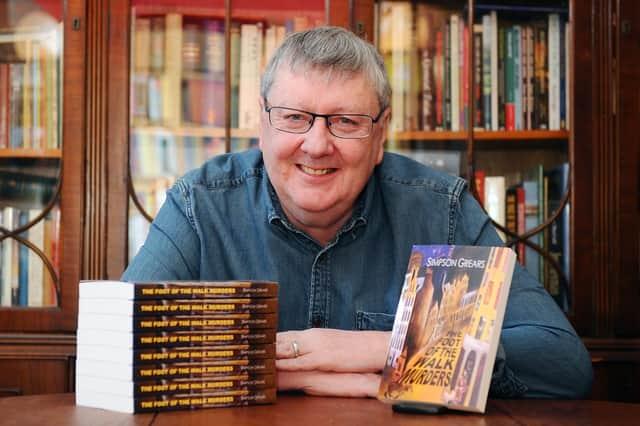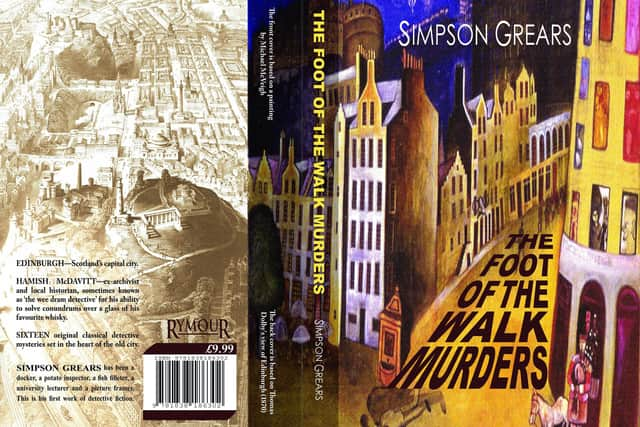The Foot of the Walk Murders, by Simpson Grears, Pt 4: This man could not have been the murderer of these poor woman


‘There is a point here’, said Ord, ‘The testimony of the witnesses is recorded, although no ring was found with the body. If the book has a virtue, it is in bringing this loose end of the evidence to the fore.’
‘OK, I suppose’, said Hamish, ‘But I’m also interested in the published photos and I haven’t seen these before.’
‘Well, you’re the photography expert.’


Advertisement
Hide AdAdvertisement
Hide Ad‘Perhaps in the social history of photography, But as regards the history of crime photography. You know a wee bit about that, don’t you?’
‘Well, yes, suppose. Photography was reluctantly accepted during the mid-nineteenth century by the diehards. However, there’s no doubt that its uses in archiving images of criminals, recording crime scenes, and as a forensic tool were instrumental in the development of modern criminology and worked hand-in-hand with other innovatory techniques such as Henry Faulds’s development of fingerprinting.’
‘There were other techniques developed – eugenics, for example?’
‘Pash,’ said Ord, ‘A load of silly nonsense. Galton, who was a moderate criminologist, had the daft idea that you could use composite photos to identify a typical criminal likeness. If you could, any policeman would tell you, it would make their job a hell of a lot easier. They could just arrest all the ugly mugs and bow and curtsey to the angelic faces! Then there was the even sillier idea that murderers and their victims had some sort of facial resemblance that could be detected. And then there was the endless photographing of hands and feet, fingers and toes, in the belief that you could identify criminal characteristics in those alone...
Advertisement
Hide AdAdvertisement
Hide AdHere, look at some of the examples in Peers-David’s book... ’
He opened the book at a centre spread of glossy black and white photographs.
‘Now’, said Ord, ‘here are some useful if rather graphic forensic photographs, showing a comparative view of the bodies of the three victims laid out flat. Look, you can see the remarkable similarity of the jagged diagonal cut in their abdomen that Peers-David claims attests to the left-handedness of the murderer.
‘The photographic record means that a detective has evidence of the nature of the offence without personally having to accompany the pathologist on the investigation of each body.
Advertisement
Hide AdAdvertisement
Hide Ad‘On the other hand,’ he said, ‘turning the page, ‘here are the photographs of the deceased Johnny Monkey, showing his face from three angles with inked on dimensions, and of his hands, palm uppermost.’
‘Why is there a deep bruise on his forehead?’ asked Hamish, suddenly perking up and furrowing his brow in the rather exaggerated way that indicated he was concentrating.
‘Oh, apparently, the rope that he had hanged himself with had broken or become undone and he had fallen against the hearth. That was how he was found, lying face down with his head bashed and his neck crushed by the heavy rope.’
Hamish scanned the images again for a moment intently, screwing his eyes together and scratching his chin. Then he rose suddenly and went to his desk, fetching a magnifying glass. He laid the book flat on an occasional table with a desk lamp to avoid direct light from the windows and, meticulously, scanned both of the hands of Johnny Monkey with the glass, then, equally carefully, each elevation of the face.
Advertisement
Hide AdAdvertisement
Hide AdOrd knew better than to interrupt him until he looked up, thoughtfully, a minute or two later.
‘Have you seen something, Hamish?’
Hamish’s thoughtfulness vanished and he suddenly seemed quite lively.
‘Yes, indeed. This man, from the evidence of these photographs, cannot have been the murderer of those poor women!’
Ord was suitably impressed by the forcefulness of this declaration and his eyes opened wide: ‘Good God, man. You’re not suggesting that you can tell that from the hands and the face? Was all that Victorian mumbo-jumbo right, do you think! That the imprint of the murderer is contained within his features?’
Advertisement
Hide AdAdvertisement
Hide AdHamish laughed. ‘No, no, nothing as fanciful, I’m afraid. Something much simpler than that. A working seaman will be commonly using knives, irons and other nautical tools. We can see if we look closely that his right hand is slightly thicker and more calloused than the left. Also, if we look closely at the face, the right-hand side has slightly more of a shadow than the left.
‘This is common when shaving with a cutthroat razor – drawing the blade across the face from the opposite side is more efficient and shaves closer. I conclude, therefore, that this man is right-handed. And yet, Timothy Peers-David has concluded from the evidence that the culprit was definitely left-handed!’
Ord thought for a minute about this and slowly nodded his appreciation.
‘So, do you think that it is, in fact, possible that Valentine was the murderer?’
Advertisement
Hide AdAdvertisement
Hide AdHamish shook his head. ‘No, there’s nothing yet strong enough to allow us to assume that, and I have noticed that although Peers-David makes a point about the left-handedness of the murderer, I haven’t yet come across his evidence that Valentine was left-handed.’
He shrugged. ‘Although, of course, it might be found on a closer reading of the book, I just don’t know.’
Hamish walked to the window and looked out towards a sky turning dark and stormy. He added, ‘But I do think that the case merits our further attention! Do you think we could have a closer look at the police file?’
‘I’ll trump that. I’ll have the whole thing taken round to my place. Tomorrow’s Sunday, and we can spend a fine day together with a special old malt I’ve been saving for you and try our hand at cracking an old mystery.’
Advertisement
Hide AdAdvertisement
Hide AdTo continue reading The Foot of the Walk Murders, by Simpson Grears, the novel is now available in paperback, priced £9.99, www.rymour.co.uk